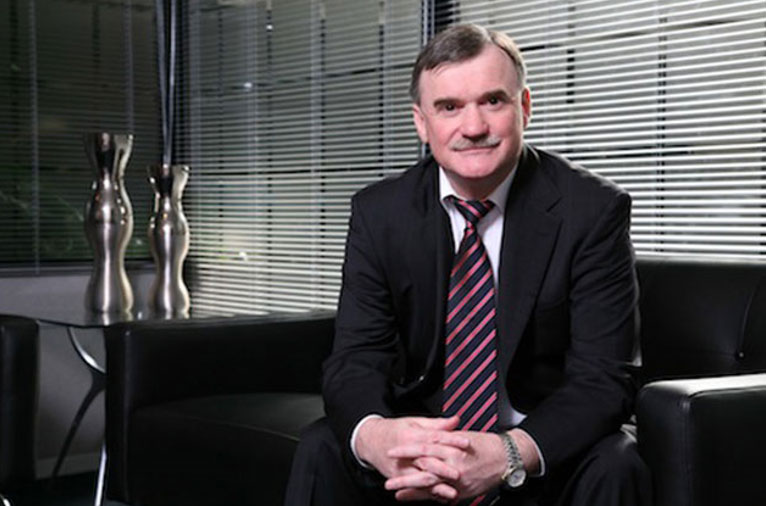CEO Spotlight: Interview with Former NET1 Technologies’ CEO Serge Belamant On the Future of Biometrics

Serge Belamant has worked with a wide range of companies in diverse industries but it is his skill and passion for coding digital financial transaction software which built him the reputation as a legend in the technology industry. His legacy is a transformative impact on the global banking industry, in particular, his technology that allowed almost 10 million beneficiaries in South Africa to receive monthly grants safely and securely.
Belamant founded Net1 Technologies in 1989 specializing in the creation of universal electronic payment systems, or UEPS, and holds a patent for the Funds Transfer System (FTS). Known for his genius in financial systems, he was approached by VISA in 1995 to design a chip offline pre-authorized card (COPAC) known as the chip-enabled credit and debit cards which, in different forms, is widely used all over the world today.
In 1999, Belamant purchased Cash Payment Services (CPS) from the First National Bank of South Africa. At the time CPS was a system that paid all the welfare grants within the RSA. The antiquated system needed modernization in paying out grants to millions of South Africans, who predominantly lived in the rural areas of the country.
Arguably Belamant’s greatest achievement was winning the contract from the South Africa Social Security Administration (SASSA) to pay all social grants throughout South Africa. Prior to 2005, SASSA did not exist and welfare grants were managed by provincial social welfare departments. Net1 Technologies and Serge Belamant reformed the payment systems that allowed 10 million South African beneficiaries to received grants each month safely and securely.
At its peak, Net1 Technology serviced more than 10,000 pay points monthly – a massive network amounting to approximately R160 billion a year which is 15% – 20% of the national government spending budget. Serge Belamant talked to us about the slow adoption of biometric technology in the sector and what this could mean for the future of social welfare and banking in South Africa?
How did you come up with the idea of biometric technology to support the welfare payments of South Africans?
“Prior to the introduction of biometric technology, many beneficiaries did not receive their payments due to corruption and fraud. With paying out so much money in benefits you are always going to have people who will abuse the system. There were members of staff who worked for the government who would register themselves instead of their clients. By doing that they would receive the grant instead of the legitimate beneficiary.”
Belamant went on to explain, “Sometimes fraudsters would set up ghost registrations pretending to be a beneficiary and collected unauthorized payments from the RSA welfare system. Elderly beneficiaries had their cards stolen or taken from them often by family members. Because of this, we knew a digital PIN wouldn’t be secure enough to keep cards from being stolen and used by others.”
“Biometric technology meant using fingerprints for identification purposes. All we needed to do was to capture the fingerprint, store their fingerprint directly into the card at the time of registration. If a card was lost stolen, it made no difference whatsoever because the card could not be used by anyone other than the person who had registered their fingerprints. In addition, we could check that the person was also registered on the HANIS system.”
“The card could not be borrowed by anyone unless of course, the beneficiary selected to allow his partner to use the card” or another authorized person of their choice. We could store all their fingerprints on the same card, but wherever the transaction took place, we always knew who had actually performed and authorised the transaction. In case of an audit, we could say to the beneficiary, “We know this transaction wasn’t you. It was your wife, or your son, daughter, or another authorized person who withdrew the cash.”
How was this biometric technology received by the government?
“It was received extremely well because previously, these services were often delivered by less reputable companies. Paying out nearly 10 million beneficiaries on a monthly basis was a huge undertaking and we had to ensure that the people entitled to these grants were in fact the ones who received these.”
“With biometric technology, it meant that any future grants distributed for whatever reason including unemployment benefits would reach the poorest of the poor. It would also enable future social programs to be managed within the same system using the same registration, using the same biometrics and the same distribution platform that would have all of the bells and whistles required to adapt itself to the future.
As you can imagine, the logistics of managing 17, 000, 000 grants a month was a serious challenge but Belamant was able to solve it by merging a variable pin and the construction of a 1: N Biometric comparison engine which allowed SASSA to operate for seven consecutive years without incident. Grants were not only delivered securely, but they were also delivered with speed.
Where do you see the future of biometric technology?
“Bringing ideas to life isn’t always easy and the first few years of Net1 Technologies were a little rough. Initially, it was hard to get banks to accept UEPS and FTS which forms the basis of this technology. It was only by continuing to challenge myself by attempting to identify the root cause of the problem which was to reach those beneficiaries who lived in underdeveloped rural areas of South Africa.”
“One thing that was very important to me at the time, was knowing the welfare system needed new technology to eliminate corruption and fraud and ensure that the poorest of the poor could receive grants regardless of where they lived in South Africa. We designed a system that now allows the government to distribute grants, quickly, and securely which means millions in South Africa have access to a financial system that works.”
This technology has many uses in the future especially in the developing world where connectivity, lack of education, and infrastructure are lacking.
Furthermore, the UEPS/EMV system is also designed to combat any cyber attacks by extortion groups or terrorist organizations. It is more and more likely that these organizations could destabilize economies by simply preventing transactional banking. The UEPS/EMV solution operates offline and it is thus impossible to block its operation. Grants and salaries can continue to be paid offline using the UEPS automatic credit facility. These features ensure that the greater population will continue transact even if banking systems as we know and use them became dysfunctional.
As a result of the success in South Africa, Net1 Technologies subsequently signed deals in Botswana, Burundi, Namibia, Ghana, Iraq, and Russia to name a few. The company continues to provide social welfare payment distribution services to the country’s large unbanked and under-banked population.
Under his leadership until his retirement in 2017, Serge Belamant took Net1 Technologies public in 2005. Net1 completed an initial public offering and listed on the Nasdaq Stock Market. In October 2008, Net1 listed on the Johannesburg Stock Exchange (JSE) in a secondary listing, which enabled the former Aplitec shareholders (as well as South African residents generally) to hold Net1 common stock directly. Serge Belamant changed the future of banking globally and given his leadership over 27 years at Net1 Technologies, you would have to conclude he is the founding father of technological social entrepreneurship in SA.
Have you read?
World’s Best Countries For A Child To Be Born In.
World’s Best Countries For Its Citizens To Live.
World’s Best Countries For Cultural Influence.
Add CEOWORLD magazine to your Google News feed.
Follow CEOWORLD magazine headlines on: Google News, LinkedIn, Twitter, and Facebook.
This report/news/ranking/statistics has been prepared only for general guidance on matters of interest and does not constitute professional advice. You should not act upon the information contained in this publication without obtaining specific professional advice. No representation or warranty (express or implied) is given as to the accuracy or completeness of the information contained in this publication, and, to the extent permitted by law, CEOWORLD magazine does not accept or assume any liability, responsibility or duty of care for any consequences of you or anyone else acting, or refraining to act, in reliance on the information contained in this publication or for any decision based on it.
Copyright 2024 The CEOWORLD magazine. All rights reserved. This material (and any extract from it) must not be copied, redistributed or placed on any website, without CEOWORLD magazine' prior written consent. For media queries, please contact: info@ceoworld.biz
SUBSCRIBE NEWSLETTER








